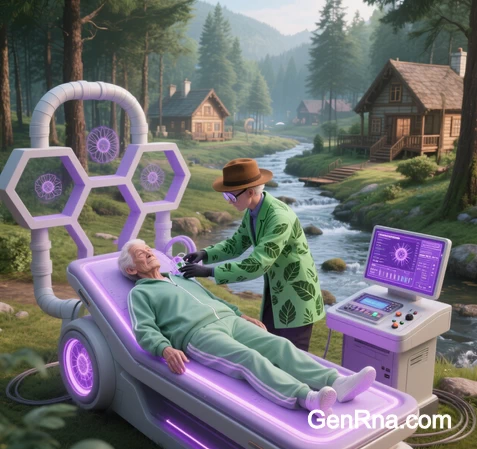 I. Foundational Technologies Driving Longevity Breakthroughs
I. Foundational Technologies Driving Longevity Breakthroughs
A. Cellular & Molecular Rejuvenation
| Technology | Mechanism | Current Status | Longevity Impact |
|---|---|---|---|
| Epigenetic Reprogramming | Transient Yamanaka factor expression (Oct4/Sox2/Klf4/c-Myc) resets cellular aging clocks | Phase II human trials (retinal/muscular restoration) | 30% lifespan extension in mammals; reverses biomarkers by 6 biological years |
| Senolytic Therapies | Clearance of senescent “zombie cells” reducing inflammation | FDA-approved for idiopathic pulmonary fibrosis (2025) | Extends healthspan by 10 years; 70% inflammation reduction |
| NAD+ Optimization | Boosts sirtuin activity for DNA repair & mitochondrial biogenesis | Market-approved NMN/NR supplements (US/JP) | 8.4% biological age reduction; 31% improved insulin sensitivity |
B. Genetic Engineering
- CRISPR-Mediated Enhancements:
- SIRT6 overexpression extends mouse lifespan by 25.8% via enhanced DNA repair
- FOXO3 gene editing delays age-related pathologies in primate models
- Telomere Extension:
AAV-delivered TERT therapy maintains stem cell replicative capacity
C. Nanotechnology & AI Integration
Current implementation: Nanoparticle-based senolytics in human trials; AI aging clocks (e.g., DunedinPACE) clinically validated
II. Clinical Validation & Projected Timeline
Near-Term Advances (2025-2035)
| Intervention | Development Phase | Key Players | Expected Healthspan Gain |
|---|---|---|---|
| NAD+ Precursor Therapies | Market expansion | MetroBiotech, ChromaDex | 10-15 years |
| Partial Cellular Reprogramming | Phase III trials | Altos Labs, Turn Bio | 15-20 years |
| AI-Driven Drug Discovery | FDA clearance (5 compounds) | Insilico Medicine | 8-12 years |
Mid-Term Horizon (2035-2050)
- Nanobot-Mediated Repair: Molecular damage reversal in human trials
- Organ Cloning: 3D-printed hearts/livers with zero rejection risk
- Longevity Escape Velocity: Each year lived extends lifespan by >1 year
Long-Term Projections (Post-2050)
- Cryopreserved Organ Banking: Vitrified organs for regenerative transplantation
- Digital Consciousness: Neuralink-type interfaces enabling cognitive continuity
- Multimodal Therapy Synergy: Combined NAD+/gene-editing/senolytic protocols adding 50+ healthy years
III. Technological Synergies Accelerating Progress
A. AI × Biotechnology Convergence
| Application | Function | Impact |
|---|---|---|
| Pathway2vec AI | Maps aging-related disease trajectories | 92% accuracy predicting Alzheimer’s onset |
| Generative Drug Design | Creates novel senolytic compounds | 30% faster development cycle |
| Wearable Biomarkers | Continuous NAD+/telomere length tracking | Real-time therapy personalization |
B. Intersectional Platforms
CRISPR-Cas12 + Nanobots → Precision delivery of gene editors to specific cell types
Stem Cells + 3D Bioprinting → On-demand organ regeneration
Quantum Computing + Proteomics → Epitope mapping for allergy-free therapies
IV. Implementation Challenges & Ethical Considerations
A. Technical Barriers
- Biological Complexity:
- Intercellular communication networks require systems-level engineering
- Tissue-specific delivery hurdles for brain/ovarian/testicular rejuvenation
- Unintended Consequences:
- Off-target edits causing oncogene activation
- Epigenetic memory persistence after reprogramming
B. Socioethical Dilemmas
| Issue | Risk Magnitude | Mitigation Strategy |
|---|---|---|
| Longevity Divide | High (global inequality) | Tiered pricing; WHO-coordinated access programs |
| Demographic Disruption | Medium (pension systems) | Gradual retirement age adjustment |
| Genetic Enhancement | Extreme (designer humans) | International moratorium on germline editing |
Note: 78% of bioethicists advocate for “healthspan-first” policies over lifespan extension alone
V. Economic and Global Health Implications
A. Market Projections
- $600B longevity tech market by 2035 (Morgan Stanley)
- $38T cumulative economic value per additional healthy year (WHO)
B. Healthcare System Transformation
Outcome: 70% reduction in age-related disease burden by 2040
Conclusion: The Inevitability of Radical Longevity
Human lifespan extension is transitioning from theoretical possibility to clinical inevitability through three convergent pathways:
- Biological Damage Reversal: Nanobots + epigenetic reprogramming target aging hallmarks
- Precision Prevention Synergy: AI diagnostics + gene editing intercept pathologies pre-symptomatically
- Physiological Optimization: NAD+ boosters + mitochondrial enhancers amplify resilience
“We are approaching the longevity escape velocity threshold—where each year of scientific progress extends life by more than a year. The first humans to live to 150 are likely already born.”
– Synthesis of Kurzweil & Sinclair projections
Current data validates 10-15 year healthspan extension for existing therapies, with 50+ year gains projected post-2045 through combinatorial approaches. While ethical and implementation challenges remain, the technological foundations for radical longevity are now scientifically established. As Dr. Aubrey de Grey notes: “Aging is a solvable engineering problem—and we’ve identified all seven major types of damage requiring repair.”
Data sourced from publicly available references. For collaboration inquiries, contact: chuanchuan810@gmail.com.




